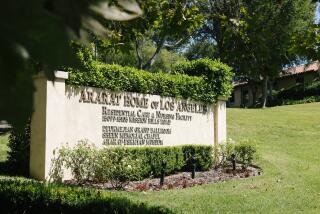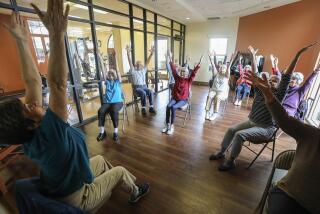22,000 Needless Nursing Home Deaths Alleged
- Share via
Federal auditors are investigating a claim that nearly 22,000 nursing home patients in California died from preventable conditions such as malnutrition, dehydration and urinary tract infections between 1986 and 1993, federal and state officials said Wednesday.
Investigators for the General Accounting Office arrived in California last week to begin looking into a voluminous complaint from a Palo Alto attorney who based his findings on a review of 300,000 death certificates.
In a letter to the GAO this month, Sen. Charles E. Grassley (R-Iowa), chairman of the Senate’s Special Committee on Aging, asked the office to investigate information gathered by attorney Von Packard.
General Accounting Office investigators visited nursing homes, began reviewing medical records and met with state health officials. They also interviewed Packard and returned to Washington with his list of 21,680 nursing home patients who died of what Packard considered questionable causes between 1986 and 1993, as well as a sampling of 1993 death certificates, Packard said.
Packard approached the Senate committee last summer with his data, which Grassley found “very disturbing,” said a Senate committee spokesman, who asked not to be identified. Grassley then contacted the General Accounting Office and on Oct. 1, after five weeks of discussion, requested a formal investigation.
Nursing home industry officials reacted angrily Wednesday, accusing Packard of seeking “free advertising” and of mimicking aggressive legal challenges to nursing homes in Florida and Pennsylvania. They said the lawyer’s method of examining death certificates was not a sound way to assess the quality of care.
“The study is just fraught with big holes,” said Lori Costa, director of regulatory programs for the California Assn. of Health Facilities, which represents 1,500 long-term care facilities in the state. “A cause of death has to be proven by autopsy.”
Grassley has asked the GAO to “independently verify” the prevalence of malnutrition, dehydration, sepsis, fractures, burns and scalding in California nursing homes, according to the letter from Grassley to the office.
“Because of the seriousness of this request and the potential life-threatening implications of its subject matter, the committee respectfully requests that the GAO address this request immediately,” the letter said.
If the claims appear to be valid, then Senate hearings on the matter are likely, the spokesman said.
California health officials said they are cooperating with the GAO and, for now, expect a review of only three Northern California facilities. The state health department, which inspects homes for the federal government, is not the target of the probe, said Brenda Klutz, deputy director of state licensing.
Klutz said she was unaware of Packard’s review until recently. But in general, a finding of malnutrition or dehydration on a death certificate, without evidence of an underlying condition such as cancer, would “raise a red flag,” she said.
“I would want to investigate further,” she said.
A UCLA epidemiologist agreed that it would be a mistake to rely on death certificates alone for anything other than general surveillance--unless the cause of death was some kind of accident.
“It may be the only way to get cheap data, but it should be interpreted with caution,” said Beate Ritz of the UCLA School of Public Health.
The GAO’s findings in California will be used to determine whether there is a national crisis of preventable deaths in nursing homes, a spokesman for Grassley’s committee said.
Grassley’s office is also looking into whether the federal Health Care Financing Administration is doing an adequate job of disciplining nursing homes where violations of federal nursing home rules are reported.
The committee spokesman said Grassley is concerned about a seemingly low percentage of nursing homes in violation of the law that are actually fined or otherwise penalized by federal regulators.
Time magazine reported Monday that only 2% of nearly 10,000 nursing homes with significant deficiencies were fined or penalized.
Health Care Financing Administration officials said Wednesday that fines and penalties are not intended to be widely used, but rather are applied only if a home does not adequately correct its problems. The low penalty rate reflects the fact that most homes fixed their deficiencies, said agency spokesman Chris Peabody.
Packard’s investigators began reviewing death certificates after meeting Ila Swan, a 57-year-old Vacaville woman who launched her own review of county death records after witnessing what she considered disturbing conditions at a home where her mother was a patient. Packard said his investigators are now launching death certificate reviews in four or five other states, but declined to name them. He began his California probe about a year ago.
Packard said he looked at the records of those who died of one or more of the following: malnutrition, dehydration, bed sores, urinary tract infections and bowel obstructions. He removed anybody from the list who had another diagnosis, such as cancer, that would have contributed to malnutrition. Of those who died of dehydration, he removed all those with Alzheimer’s disease, which often prevents swallowing in its advanced stages, he said.
“This is very understated,” he said of his data. “There is a widespread pattern of severe neglect.”
Based in part on Packard’s findings, the Senate committee is also looking at the overall risk of malnutrition in nursing homes.
More to Read
Get the L.A. Times Politics newsletter
Deeply reported insights into legislation, politics and policy from Sacramento, Washington and beyond. In your inbox twice per week.
You may occasionally receive promotional content from the Los Angeles Times.











